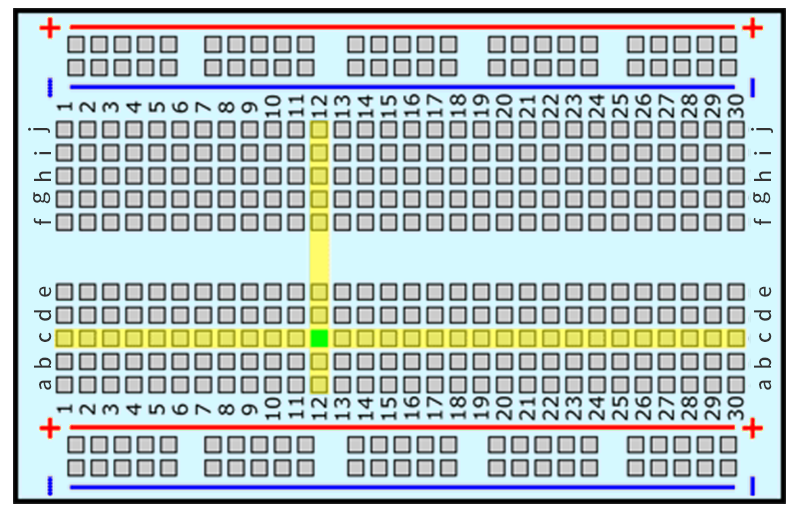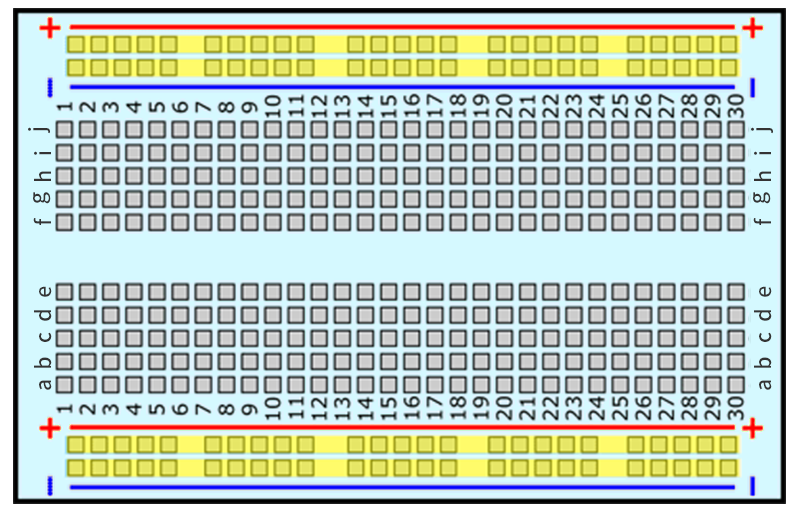Breadboard¶
What is a “solderless” breadboard?

A breadboard is a rectangular plastic board with many small holes in it. These small holes allow you to easily insert electronic components to build circuits. Technically speaking, these breadboards are known as solderless breadboards because they do not require soldering to make connections.
Features
Size: 163 x 54 x 8 mm
830 tie points breadboards: 630 tie-point ic-circuit area plus 2x100 tie-point distribution strips providing 4 power rails.
Wire size: Suitable for 20-29 AWG wires.
Material: ABS Plastic Panel, Tin Plated Phosphor Bronze Contact Sheet.
Voltage / Current: 300V/3-5A.
With Self-Adhesive Tape on the Back
What is in the breadboard?

The inside of the breadboard is made up of rows of small metal clips. When you insert the leads of a component into the holes of the breadboard, one of the clips catches it. Some breadboards are actually made of clear plastic, so you can see the clips inside.
What do the letters and numbers on a breadboard mean?

Most breadboards have some numbers, letters and plus and minus signs on them. Although the labels will vary from breadboard to breadboard, the function is basically the same. These labels allow you to find the corresponding holes more quickly when building your circuit.
The row numbers and column letters help you to precisely locate the holes on the breadboard, for example, hole “C12” is where column C intersects row 12.
What do the colored lines and plus and minus signs mean?

The sides of the breadboard are usually distinguished by red and blue (or other colors), as well as plus and minus signs, and are usually used to connect to the power supply, known as the power bus.
When building a circuit, it is common to connect the negative terminal to the blue (-) column and the positive terminal to the red (+) column.
How are the holes connected?

As shown in the diagram, each set of five holes in the middle section, columns A-E or F-J, is electrically connected. This means, for example, that hole A1 is electrically connected to holes B1, C1, D1 and E1.
It is not connected to hole A2 because that hole is in a different row with a separate set of metal clips. It is also not connected to holes F1, G1, H1, I1 or J1 because they are located in the other “half” of the breadboard - the clips are not connected across the middle gap.
Unlike the middle section, which is grouped by five holes, the buses on sides are electrically connected separately. For example, the column marked blue (-) is electrically connected as a whole, and the column marked red (+) is also electrically connected.
Which electronic parts are compatible with breadboards?

Many electronic components have long metal legs called leads. Almost all components with leads will work with a breadboard. Components such as resistors, capacitors, switches, diodes, etc. can be inserted in any of the rows, but ICs need to be arranged across the middle gap.